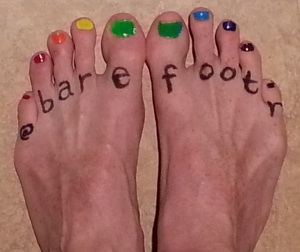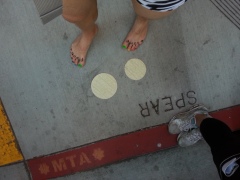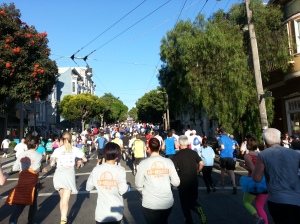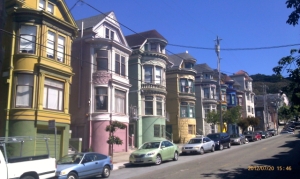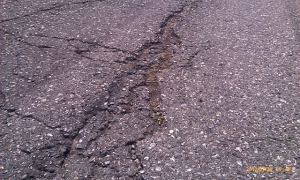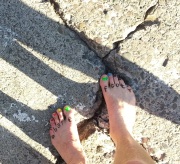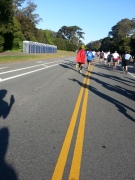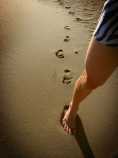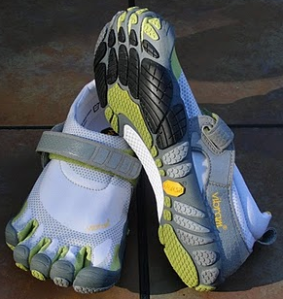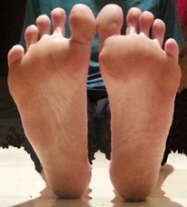Archive
Bay To Breakers – Barefoot
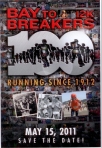
The centennial running of the Bay To Breakers 12K will take place in San Francisco this Sunday May 15, 2011. Last year, I ran it in my KSO’s, while carrying a pair of lightweight trainers as a back-up just in case my feet couldn’t take the full distance in the KSO’s. I had been using the VFF’s for about 5 months at that point and I knew that 7.5 miles would be pushing it. I made it the whole way at a decent but not killer pace for me (~7:30′ or 7:45′ miles), though last ~2 miles were tough.
This year I plan to up the ante. The plan is to run barefoot at least to the top of Hayes Street and tote a pair of VFF’s to don when my soles need a break. It’s not quite on par with Abebe Bikila, but I think it will be a fitting way to commemorate the 100th anniversary of this famous foot race.
I encourage other minimalist shoe runners doing the #B2B100 to join me in this challenge. If you do go bare, be extremely vigilant of random junk on the course — think safety first! If you’re interested in meeting up after the race, aim for letter “B” at the Footstock alphabet garden in Speedway Meadow around 9:30am. Take off your shoes so we can find each other!
Abebe Bikila – Barefooter wins 1960 marathon
Abebe Bikila represented Ethiopia sans shoes in the 1960 Rome Olympics and became the first black African to win gold. Truly inspirational. He ran barefoot because he was unable to find a comfortable pair of running shoes and he had been regularly training barefoot. There are some other videos here and here — the latter had close-up slow-motion of Abebe running, but it appears to have been pulled from YouTube :(.
According to the Wikipedia article he made the decision to go barefoot just a few hours before the race and had trained for the race barefoot. Ultimately he did it because, in his words, he “wanted the world to know that my country, Ethiopia, has always won with determination and heroism.”
In 2010, fifty years after Abebe’s historic win, Vibram released its Bikila model of VFFs, helping to bring Abebe-style running to the masses. Click on image for a good review of the Bikilas.
Do you think we’ll ever see another barefoot Olympic marathoner? Perhaps a VFF-er?
Barefoot running
This post originally appeared in my blog in May 2010 and is a good summary of my initial experiences with VFFs. It also has an assortment of barefoot running links.
I got some Vibram 5 Fingers (VFF) shoes at the end of December 2009 and during the past 4 months I’ve been experimenting with running in them, to get my feet wet in this barefoot running business that has been much in the news of late. (Technically-minded folks will note that if you’re wearing these shoes you’re not barefoot, but you’re pretty darn close.)
I’ll use this post to provide some background links as well as describe my first-hand experiences. I included a couple of self-photos of my KSO’s: the first shot was taken during the first week I had them, and the second was taken about 3 months later, after wearing them during the run portion of the Golden Bearathlon. It was a muddy 10K trail run and the shoes cleaned up nicely in the wash. I don’t do all my runs in these shoes now, but I’m gradually moving in that direction.
Goodbye Orthotics
Probably the most powerful thing I can say from my experiences would be this: Since I started running in the VFFs, I have dropped my dependency on the custom orthotics that I’ve worn religiously for the past 15 years. In 1995, I had the orthotics made and wearing them greatly reduced my running injuries; basically I never did a run or went anywhere without them since ’95.
However, this has all changed since I’ve been running in the VFFs. These minimalist shoes are basically socks with some rubber on the soles — you cannot wear orthotics in them (well, you could, but it would feel very clunky and biomechanically unnatural). So I’ve stopped wearing the orthotics whenever I run, even when I run with regular, heavy-soled running shoes. I have not encountered any chronic running injuries since, and I no longer need to worry about where my orthotics are at all times (though I still prefer them if I have to do a lot of walking/standing, e.g., spending the day at Disneyland).
Gradual Adaptation
I’ve been running for fitness for the past 30+ years wearing conventional, cushy, industry-standard running shoes (usually something neutral like the Asics Gel Nimbus). Since running in the VFFs, it’s become apparent how woefully undertrained my calves were. By promoting a rear-foot strike (RFS) running form (i.e., landing initially on your heel, then rolling off the toe), standard running shoes effectively shield the calves from doing much work.
Before I acquired the VFF shoes, I spent 1-2 months working on a more fore-foot strike (FFS) running style using my traditional thick-heeled running shoes. This included some barefoot running on grass. I experienced lots of calf soreness during this period, especially after harder, faster training sessions. It took a while to switch my running form from RFS to FFS — I’d say a solid two months before it started to feel natural. I was lucky enough to get some great coaching from local track coach Steve Kraft to help me learn this new running style, which has more elements to it than just foot strike.
Once I got the VFFs and started doing faster and longer runs in them, my calves experienced even more soreness. I took it fairly easy, running only on soft surfaces (like trails or rubberized tracks) once every 1-2 weeks in the VFFs, using my standard cushy shoes for all other runs. The first time I did a mile’s worth of total speedwork in the VFFs, my calves were sore for a week, hard to walk or even bike for the first few days after. Additional feedback on my VFF running form from other experienced runners revealed that I was running too much on the balls of my feet, putting excessive strain on my calves. With practice, I was able to adopt a more neutral foot strike.
Morals:
- Be extremely gradual in adding speed and mileage to your VFF runs.
- Get some feedback from a running coach or experienced runners.
Update, 19 May 2010: Here are a few additional thoughts and tips on barefoot or minimalist shoe running:
Are they comfortable?
This is the most common question I get from random, inquisitive strangers that notice my VFFs when I’m out in public with them. In short, yes they are quite comfy when just lounging around in them. But note that they give about the same degree of support as a pair of socks, so spending a full day standing/walking around in them on pavement will really wipe you out the first time you try it. About two months after I started wearing them I spent two back-to-back days wearing them while visiting Disneyland with my family — this was definitely overdoing it.
The lightness of being barefoot
The lack of weight at the end of your legs while running is quite addicting. It leads to much less torque on your overall leg motion and permits a more natural gait and more efficient cadence. The low weight and lack of bulk of the VFFs also makes them highly portable. I actually biked with them in a fanny pack, along with a bunch of other gear, for the entire MS150 bicycle ride from Houston to Austin in April 2010. They were my après-cycling footwear.
Running shoe built-into your legs
Barefoot-style running trains your leg muscles, feet, joints, and connective tissues to learn to do more of the shock absorbtion that we’ve been delegating to conventional running shoes. Running barefoot or with minimalist shoes like VFFs trains your legs to acquire those shock absorbing powers, essentially building a running shoe into your body. Transitioning from a RFS to a FFS style and adapting to minimalist shoes feels like it has given my running legs another “gear” that I can employ regardless of my footwear. It is a more muscular style of running where the legs learn how to absorb the shocks of running and even obtain some elastic recoil from each foot strike. With a RFS running style where the shock of each footstrike is dissipated via the heel, shocks are absorbed primarily via the shoe plus your skeleton, which dissipates the impact energy and provides no recoil opportunity (and can in fact lead to loss of forward momentum via braking).
Easy does it
As Barefoot Ken Bob warns: Don’t do too much too soon! There’s a strong temptation to overdo it, especially as your feet and legs start adapting. But it really takes quite a bit of time to fully adapt to a barefoot or minimalist shoe running style. The transition is more difficult and longer for folks (such as myself) with a long history of RFS style running.
When starting out, pick the smoothest surfaces you can (such as grass, astroturf, or a rubberized track). Our soft, modern feet take a major pounding when running and bruise/blister incredibly easily. The first time I stepped on a rock the wrong way with the VFFs I got a bruise on the ball of my foot that was tender for several days, and even after 5 months of using the VFFs, I still get hot spots and bruises when I push the pace or terrain (though my feet now recover much faster). Over time, you will learn how to run more gently and your feet will toughen up, but it takes months (maybe up to a year), and you still must always be mindful of your terrain. The plus side of having barefoot/minimalist shoe running is it provides great feedback from the running surface that is otherwise masked by standard heavy-soled running shoes. Especially when running on trails, each footstep is unique, giving you a deeper sense of connectedness with your environment and increasing the mental stimulation of running. It can be very reflexology-like. Run barefoot for best results here (feet and terrain-permitting).
Variety is the spice
Even if you are skeptical about the benefits of barefoot/minimalist shoe running and think it’s yet another passing fad, you’ve got to admit that it is way different than what the running shoe industry has been doing for the past 30+ years and it gives a runner something new to play with. Use it to inject variety and shake up your routine, get out of your comfort zone, and keep your workouts from becoming stale. This all helps to keep you motivated, which is key to long-term success in sticking with your fitness goals.
Foot stretches.
Stretching helps rejuvenate tired feet, especially when walking/standing in them for long periods. Here are some stretches, all of which can be effectively performed while wearing VFFs (but not with standard shoes!):
- Flex and point toes, alternating and holding the stretch and point for ~5 seconds each.
- Foot circles or “alphabets” where you trace each letter of the alphabet with your foot (caps or cursive).
- Gripping with toes. Imagine you are trying to grab a ball with your toes. This motion is almost like pointing your toes while dorsiflexing. ‘Grip’ and hold for a few seconds. Relax by dorsi-extending and fanning toes.
- Top of toes on ground. Can be done when standing or sitting. Standing on one leg, bend other knee and point toes behind you, attempting to touch the top of foot on the ground behind you. Hold and breathe.
- Foot massage. While sitting, cross on leg and work one foot at a time. Use your thumb to massage the plantar fascia. Also massage the lower achilles tendon area around the sides of the heel.
Use powder
Applying talcum powder on the inside of the VFFs helps a lot in fighting microbial odors and easing foot entry. I like Burt’s Bees; Dr. Scholl’s also sells powders with antimicrobial additives. Washing the VFFs with a powdered detergent once/week on a gentle or ‘easy care’ cycle then air drying keeps them in good shape. Just throw them in with your other laundry.
Additional Links:
- Chris McDougall – Born To Run author, kicked off the most recent VFF/barefoot running craze.
- The Roving Runner Goes Barefoot (NYTimes, 5 Oct 2009)
- History/motivation behind writing of the book “Born to Run” (YouTube)
- Appearance on John Stewart (Aug 2009)
- Talks about wearing vibram five fingers(15 Jun 2009)
- Chris McDougall’s informal Google talk (16 Oct 2009)
- Lieberman et al. Nature paper, Jan 2010: “A comparison of the biomechanics of habitually shod versus habitually barefoot runners suggests that running barefoot is not only comfortable but may also help avoid some impact-related stress injuries.”This begat a flurry of other reports appearing in Jan 2010:
- The Barefoot Professor Daniel Lieberman (YouTube video, Harvard University study, 1/27/10)
- Study: Humans were born to run barefoot (NPR, 27 Jan 2010)
- ScienceDaily coverage of Lieberman study (ScienceDaily, 1 Feb 2010)
- Running Shoes May Cause Damage to Knees, Hips and Ankles, New Study Suggests (Science Daily, Jan. 6, 2010)
- Study: Running Shoes Could Cause Joint Strain (LiveScience, 12 Jan 2010)
- Running Shoes Changed How Humans Run (LiveScience)
- Wikis and Blogs:
- Barefoot running icons:
- Pose Running method:
- Pose technique originated in the 1970’s by Dr. Nicholas Romanov.
- Heel striking is way bad, according to the Pose experts.
- Opinions on barefoot running:“I would like to mention that barefoot running is not a panacea for avoiding running problems, it is not an automatic guarantee of running proper. It is just another tool for learning to run proper, because of more elements of a proper running technique present there than anywhere else.”
- Pose advocates claim that their method applies to any sport.
- Other links:
- Wiggling Their Toes at the Shoe Giants(29 Aug 2009)
- Is it the shoes? It’s gotta be the shoes. (YouTube comparison no shoes and with shoes)
